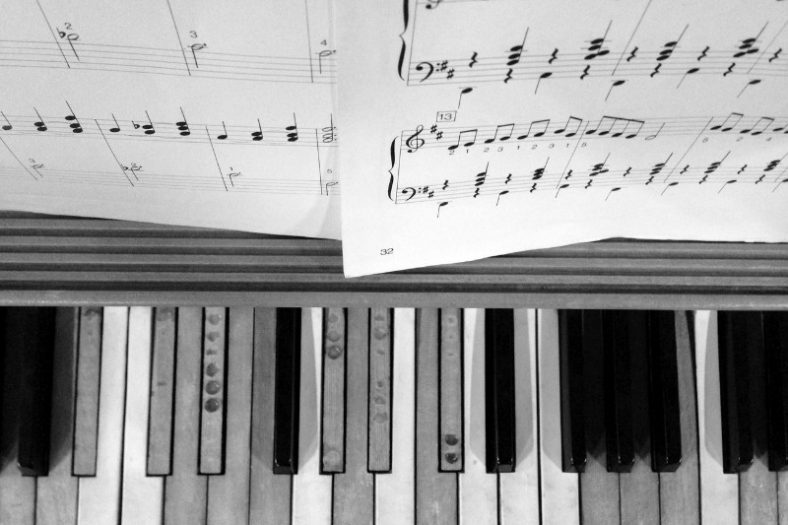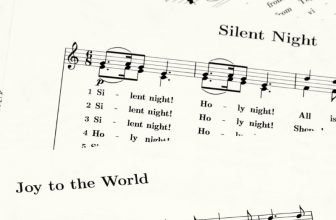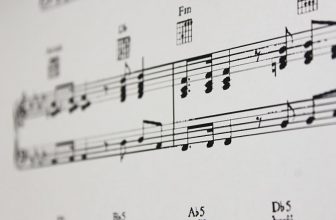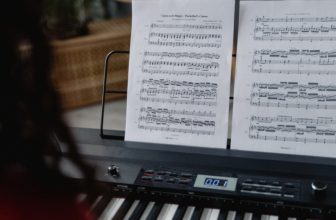Types Of Melody in Music – The Ultimate Guide

A melody is a succession of pitches ordered according to a specific rhythm. Melody is different from harmony because it works as the main hook of a song, while harmony provides the background information of the arrangement.
Melody is described as the horizontal movement of a musical piece because it’s what drives the song forward. Harmony, on the other hand, provides the vertical movement of a musical piece because it acts to support and reinforce the song’s main melody.
It’s impossible to list all types of melodies that have existed or are yet to exist. According to Plus.Maths, a mere ten-note sequence can produce more than 75 billion different melodies! However, all melodies have a distinctive set of elements. They also differ in terms of texture, motion, and style.
By considering these basic melodic notions, it’s possible to study any melody in the broader context of music. Learning more about what makes melodies different from one another is also useful for finding inspiration to create new melodies.
Melodic elements
Melodies can be radically different from one another. However, all melodies have a basic set of elements. According to the author Vernon Kliewer, there are five melodic elements in music: pitch, duration, texture, timbre, and loudness.
Let’s take a closer look at each of these:
1. Pitch
All melodies are composed of one or more pitches, which are simply the musical notes that make up the melody. Pitch is perhaps the most significant element in any melody because it’s the part that sticks to the brain. it’s the sequence of notes that you hum once you listen to a catchy song.
Melodies can have extremely complex sets of pitches, sequenced in many ways. However, they can also be rather simple. The nursery rhyme “The Rain Is Falling Down,” for instance, uses just three different musical notes: B, A, and G. While also very simple, the “Happy Birthday” theme is made of seven different notes: G, A, C, B, D, E, and F (all the notes in a classic Major scale).
The vast majority of pop-music melodies are made of seven or fewer different notes, but a melody can have as many notes as desired. In Serialism, for example, melodies are composed of serial patterns of 12 notes (the maximum number of notes you can find in a Western-music instrument).
2. Duration
In a melody, duration refers to how long a pitch (and ultimately, the entire sequence of pitches) lasts. In other words, it sets the rhythmic nature of a series of pitches. Pitch defines the melodic structure of a song, as notes can be repeated, go up, or go down. Duration, on the other hand, defines how long each one of these notes lasts, how they’re spaced out, and when the overall melody starts and ends.
In simpler terms, duration is the time of a melody. Duration is very important for melody because it helps to set the feel of the pitch. The very same sequence of pitches can sound upbeat if played very fast, but ominous if played very slowly. At a certain rhythm, a given melody can sound like rock music. On another rhythm, the very same melody can sound like jazz.
3. Texture
The melodic texture is the interaction between different voices in a melody. What does this mean? It simply means that texture refers to the character of simultaneous pitches in a song. It’s a tough concept to grasp because it can be easily confused with harmony. However, melodic texture and harmony are not the same.
Let’s take a look at two examples to understand what melodic texture’s all about. The first is a short cover of “My Heart Will Go On” on the recorder (an instrument that can only play one voice at a time), whereas the second is a cover of the same song on the piano (an instrument that can play multiple voices at the time).
In this video, the musician is playing “My Heart Will Go On” one note at a time, which means he’s not making the most of the texture.
In this video, the musician is playing the melody of “My Heart Will Go On” using two notes at a time, hence providing it with a certain amount of texture.
The melodic texture, however, excludes the arpeggio that the pianist is playing with his left hand (which is the harmony). By focusing on his right hand alone, you can see that the musician’s “texturally” styling the melody by playing more than just one note at a time.
4. Timbre
Timbre is often described as the “character” or “tone color” of a melody. The best way to understand what timbre is, however, is to think of it as the instrument that’s playing the melody.
Timbre is a more relative melodic element because it’s interchangeable. If you make significant changes to the pitch, duration, or texture of a melody, you’re no longer playing the same melody. However, you can play any melody in radically different instruments (i.e., radically different timbres) without changing it.
If you listen to a cover of “Yesterday” played on the piano and a cover of “Yesterday” played on the theremin, you can immediately notice that the two have a very different timbre. Yet, you’d surely be able to recognize that both musicians are playing “Yesterday” regardless of how different their instruments sound.
5. Loudness
Just like timbre, loudness is an interchangeable melodic element. It refers simply to how loud a melody’s being played. This can have a significant impact on the character of a melody.
Loudness is also very important for setting the style of a song. For example: along with other new approaches, this metal musician managed to cover Adele’s “Hello” in a different style by playing the song louder.
Melodic textures
The melodic texture is all about the interaction between different pitches in the context of a melody. In other words, a melody that starts with a C sounds different from a melody that starts with a C and G played simultaneously.
There are four main types of melodic textures: monophonic, homophonic, polyphonic, and heterophonic.
1. Monophonic
A monophonic texture is made out of a single, unaccompanied series of musical notes. While many instruments can combine to play monophonically, monophonic textures are usually played by a single voice (i.e., a single instrument).
Here are some examples of monophonic textures in music:
Anytime you sing a tune in the shower, you’re producing a monophonic texture. Janis Joplin did it best with her seminal song “Mercedes-Benz.”
2. Homophonic
Homophonic textures are the most common type of melodic textures in pop music. They’re like monophonic textures that are accompanied by either a series of chords (harmony) or other voices (arrangement).
A defining characteristic of homophonic textures is that they have a distinguishable main melody. Even though several voices are playing simultaneously, you can still hear the main melody as if it was a monophonic texture.
For a better glimpse of how homophonic textures work, please check this YouTube video by Dave Conservatoire.
3. Polyphonic
Polyphonic textures are made of two or more separate lines of melody. Unlike homophonic textures, polyphonic textures don’t have to be accompanied by chords or other instruments to be described as so. The main melody itself consists of simultaneous musical notes.
Below, you can find a polyphonic singer in action:
4. Heterophonic
Heterophonic textures are the less common type of texture and they’re usually found in non-Western compositions. Using this texture requires some know-how since heterophonic melodies are made of the main melody and variations of the main melody, playing simultaneously.
Perhaps the best way to understand heterophonic texture is to see it applied to a well-known tune. Do you know the popular nursery rhyme “Twinkle Twinkle Little Star?” Well, here’s the same song but covered in a heterophonic style.
Melodic motions
The melodic motion describes the movement of the pitches in a melody. All melodies have a melodic motion unless they consist of one single, repeated note. Despite its name, melodic motion doesn’t describe the rhythm of a melody – it merely applies to how musical notes move to one another.
In other words, melodic motions concern the up-or-down movement of pitches in terms of their frequency. You can learn more about what determines pitch in this article.
There are four main types of melodic motions: ascending, descending, undulating, and arc.
1. Ascending
An ascending musical motion occurs when one pitch moves to a higher pitch. If a melody goes from one note to a higher note (for instance, from C3 to C4), its motion is described as ascending.
2. Descending
A descending musical motion occurs when one pitch moves to a lower pitch. It’s the opposite of an ascending motion.
3. Undulating
An undulating musical motion occurs when a melody moves repeatedly up and down, especially if such happens in a series of relatively similar intervals. It’s a combination of ascending and descending motions.
Ascending (up), descending (down), and undulating motions (up-down) can be quickly sampled with the help of an arpeggiator. For a brief example of how Ableton Live’s Arpeggiator covers all of these motions, check out this video.
4. Arc
Arc is a more complex musical motion that uses both ascending and descending movements but combines them narratively. Arc motions simulate the emotional development of a story.
There are some ups and downs (undulating motion) followed by a big ascending movement (a climax) that is followed by an equally significant descending movement (the ending of the climax).
Arc musical motions are known as such because they’re similar to an arc when written as a piece of sheet music. They’re comparable to most book/movie plot lines, which start with a familiar place, followed by an adventure, a climax, and then an inevitable return home. The “Rick and Morty” creator Dan Harmon takes the concept even further with his eight-step story circle.
Melodic style
Unlike melodic textures and motions, which can be explained in music-theory terms, melodic style relates to how you “feel” the music. It’s not about the actual content of the melody, but rather its emotional impact.
However, this doesn’t mean that melodic styles are merely subjective. Most people agree that this is a happy melody and that this is a sad melody. Most crucially, it’s possible to learn how to make music that invokes specific emotions with the help of actual music-theory concepts, such as rhythm, scales, modes, and arrangement.
With this in mind, I’ll be taking a look at some of the most prominent melodic styles around:
Happy
Good music makes me happy every single time, but how does one create melodies that sound happy? Luckily, it’s very easy to come up with a cheery tune. Try to play at a high tempo using a Major scale and avoid using too many different notes. Repetition is key for making a catchy, snappy melody.
Sad
For a sad melody, try to do the opposite. Playing slowly is surely a plus, especially if you’re trying to come up with something melancholic. Using a Minor scale should also make your job a whole lot easier. For more info on musical scales, check this beginner’s guide.
Energetic
Contrary to happy and sad melodies, energetic melodies are all about the rhythm. Try to play a series of catchy notes as fast as possible and don’t complicate it too much: simplicity is key to creating a melody that makes everyone dance.
Danzel’s vocal motif in “Pump It Up” makes for a great example of an energetic melody. Adding a nice beat is always a plus!
Ethereal
Also described as abstract, ambient, or atmospheric. To create a melody that sounds like a calm winter’s breeze, the key is to forget about pitch and focus on timbre. If the timbre’s right, all it takes is one note to create a nice ethereal melody.
Here are some tips on how to create ambient music.
Complex
Popularized by prog-rock and the likes of Frank Zappa, complex melodies take… complexity. Try to use as many tricks as possible and avoid the easiest solution to come up with something unique.
Applying mathematical principles to the composition process is always a plus. Combining different scales or using less-known modes is also helpful. To get that complex feel in your melody right away, a great hack is to use odd time signatures such as 12/8 or 7/4.
Violent
Violent, virile, in-your-face melodies are the standard in rock-hard music genres. Using the blues scale (or at least the blues note) is one of the best ways of achieving that metal vibe in no time. However, loudness is as important as pitch and duration when it comes to this melodic style.
Violent melodies don’t have to be fast to hit the target, but a steady rhythm sure helps.
Summary
There’s perhaps no greater concept in music than the concept of melody. It’s what sticks with us, what makes us feel emotional, what connects musicians and audiences, the sounds we hum when we’re happy and listen to when we’re sad…
If you’re into making music, mastering and understanding this concept should be one of your top priorities.





